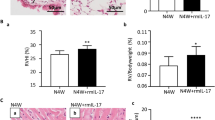Abstract
Hypoxia has been shown to activate the pleiotropic cytokine TNFα in the lung. TNFα in turn, is known to induce pulmonary vasoconstriction. Additional effects of this cytokine in hypoxia mediated cardiopulmonary remodeling are poorly understood. To further evaluate the role of TNFα in chronic hypoxia we exposed TNFα null (TNFα–/–) and wild-type mice to three weeks of hypobaric hypoxia (10% O2). Equivalent erythocytosis (Hematocrit increased by ≥ 40%) developed in both genetic backgrounds. In contrast, right ventricular systolic pressure increased in response to three weeks of hypoxia in the wild-type mice (≥ 75%), yet was unaltered in the TNFα–/– mice. Concomitantly right ventricular hypertrophy was attenuated in the TNFα–/– mice (35 ± 5% increase) when compared to wild-type mice (124 ± 6% increase p < 0.001, n ≥ 20). Interestingly in both strains the lung wet weights increased to a similar degree in response to hypoxia. In conclusion, our data demonstrate that TNFα is an integral autocoid in chronic hypoxia mediated right ventricular hypertrophy. Moreover, additional components of cardiopulmonary remodeling may be regulated by TNFα signaling as suggested by the negligible right ventricular systolic pressure response to hypoxia in the absence of TNFα.
Similar content being viewed by others
References
Taylor CT, Fueki N, Agah A, Hershberg RM, Colgan SP: Critical role of cAMP response element binding protein expression in hypoxia-elicited induction of epithelial tumor necrosis factor-alpha. J Biol Chem 274: 19447–19454, 1999
Kubo K, Hanaoka M, Hayano T, Miyahara T, Hachiya T, Hayasaka M, Koizumi T, Fujimoto K, Kobayashi T, Honda T: Inflammatory cytokines in BAL fluid and pulmonary hemodynamics in high-latitude pulmonary edema. Respir Physiol 111: 301–310, 1998
Pisetsky DS: Tumor necrosis factor blockers in rheumatoid arthritis. N Engl J Med 342: 810–811, 2000
Coker RK, Laurent GJ: Anticytokine approaches in pulmonary fibrosis: Bringing factors into focus. Thorax 52: 294–296, 1997
Miyazaki Y, Araki K, Vesin C, Garcia I, Kapanci Y, Whitsett JA, Piguet PF, Vassalli P: Expression of a tumor necrosis factor-alpha transgene in murine lung causes lymphocytic and fibrosing alveolitis. A mouse model of progressive pulmonary fibrosis. J Clin Invest 96: 250–259, 1995
Piguet PF, Vesin C: Treatment by human recombinant soluble TNF receptor of pulmonary fibrosis induced by bleomycin or silica in mice. Eur Respir J 7: 515–518, 1994
Sack MN, Smith RM, Opie LH: Tumor necrosis factor in myocardial hypertrophy and ischaemia - an anti-apoptotic perspective. Cardiovasc Res 45: 688–695, 2000
Marino MW, Dunn A, Grail D, Inglese M, Noguchi Y, Richards E, Jungbluth A, Wada H, Moore M, Williamson B, Basu S, Old LJ: Characterization of tumor necrosis factor-deficient mice. Proc Natl Acad Sci USA 94: 8093–8098, 1997
Disch DL, Rader TA, Cresci S, Leone TC, Barger PM, Vega R, Wood PA, Kelly DP: Transcriptional control of a nuclear gene encoding a mitochondrial fatty acid oxidation enzyme in transgenic mice: Role for nuclear receptors in cardiac and brown adipose tissue expression. Mol Cell Biol 16: 4043–4051, 1996
Liu SF, Dewar A, Crawley DE, Barnes PJ, Evans TW: Effect of tumor necrosis factor on hypoxic pulmonary fasoconstriction. J Appl Physiol 72: 1044–1049, 1992
Yokoyama T, Nakano M, Bednarczyk JL, McIntyre BW, Entman M, Mann DL: Tumor necrosis factor-α provokes a hypertrophic growth response in adult cardiac myocytes. Circulation 95: 1247–1252, 1997
Jacobs M, Staufenberger S, Gergs U, Meuter K, Brandstatter K, Hafner M, Ertl G, Schorb W: Tumor necrosis factor-alpha at acute myocardial infarction in rats and effects on cardiac fibroblasts. J Mol Cell Cardiol 31: 1949–1959, 1999
Kapadia SR, Oral H, Lee J, Nakano M, Taffet GE, Mann DL: Hemodynamic regulation of tumor necrosis factor-alpha gene and protein expression in adult feline myocardium. Circ Res 81: 187–195, 1997
Yokoyama T, Sekiguchi K, Tanaka T, Tomaru K, Arai M, Suzuki T, Nagai R: Angiotensin II and mechanical stretch induce production of tumor necrosis factor in cardiac fibroblasts. Am J Physiol 276: H1968–H1976, 1999
Kubota T, McTiernan CF, Frye CS, Demetris AJ, Feldman AM: Cardiac-specific overexpression of tumor necrosis factor-alpha causes lethal myocarditis in transgenic mice. J Card Fail 3: 117–124, 1997
Craig R, Larkin A, Mingo AM, Thuerauf DJ, Andrews C, McDonought PM, Glembotski CC: p38 mitogen-activated protein kinase and nuclear factor-κB collaborate to induce interleukin-6 gene expression and release. J Biol Chem (in press)
Hirota H, Chen J, Betz UA, Rajewsky K, Gu Y, Ross J Jr, Muller W, Chien KR: Loss of a gp130 cardiac muscle cell survival pathway is a critical event in the onset of heart failure during biomechanical stress. Cell 97: 189–198, 1999
Chien KR: Stress pathways and heart failure. Cell 98: 555–558, 1999
Hanasato N, Oka M, Muramatsu M, Nishino M, Adachi H, Fukuchi Y: E-4010, a selective phosphodiesterase 5 inhibitor, attenuates hypoxic pulmonary hypertension in rats. Am J Physiol 277: L225–L232, 1999
Matsumori A, Ono K, Sato Y, Shioi T, Nose Y, Sasayama S: Differential modulation of cytokine production by drugs: Implications for therapy in heart failure. J Mol Cell Cardiol 28: 2491–2499, 1996
Author information
Authors and Affiliations
Corresponding author
Rights and permissions
About this article
Cite this article
Smith, R.M., McCarthy, J. & Sack, M.N. TNF alpha is required for hypoxia-mediated right ventricular hypertrophy. Mol Cell Biochem 219, 139–143 (2001). https://doi.org/10.1023/A:1010811414206
Issue Date:
DOI: https://doi.org/10.1023/A:1010811414206




